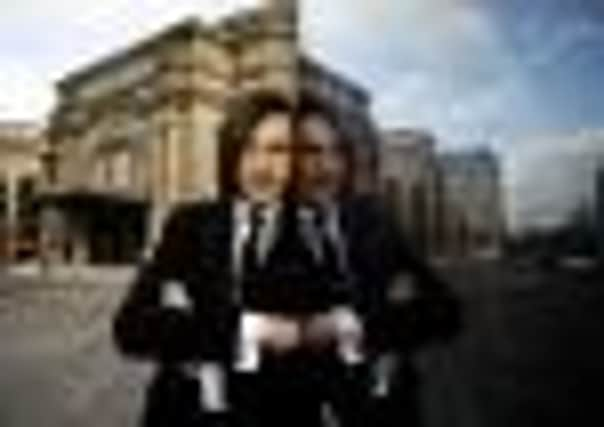Spirit of the 1920s lives on in Edinburgh seance


While it may be difficult for residents to imagine another building standing in place of the Usher Hall, the Lothian Road School was in fact part of the Capital for more than three decades.
Built in 1881, on the corner of Cambridge Street and Grindlay Street, the building was demolished shortly before the Usher Hall was erected in 1914. Prior to its closure and subsequent demolition, around 12 of the boarding school’s pupils died. Although most of the deaths were thought to be linked to natural causes such as tuberculosis, a few remain unexplained and some stories even suggest that a few of the children may have died in an “unexpected accident”.
Advertisement
Hide AdAdvertisement
Hide AdWith very little information available, however, it is unlikely the real cause of death will ever be known.


But Edinburgh magician and hypnotist Scott Smith, who is hosting a séance at the Usher Hall later this month as part of a Hallowe’en event, is hoping he can contact one of the deceased pupils by using a ouija board.
The 22-year-old, who lives in Haymarket, said he will attempt to contact the pupil to whom the audience is most drawn – after being shown a photograph of all 12 who died – in an attempt to find out his or her story and how they died.
“I have spoken to a lot of people who work at the Usher Hall and many said they had felt a presence of someone on stage – a little girl,” he said.
Advertisement
Hide AdAdvertisement
Hide Ad“Most of the things that happen on the evening will be outwith my control, so it’s going to be playing on the audience’s desire to believe, and seeing whether that will lead something to happen on the night.”


Scott, who studied hypnosis in Milan at the age of 15 and has been working as a full-time magician since graduating from Queen Margaret University last summer, will recreate the spiritualism of the 1920s – when séances were common – during the show.
Séances were familiar sights, particularly among the upper classes, at homes across the Capital during the late 19th and early 20th centuries. Gathered around a table in the drawing room of their homes, bereaved families or a group of friends desperate to make contact with the spirits of the deceased would join hands with a medium, chant loudly and wait with baited breath in the darkness for that all-important moment.
The slightest noise, movement or even smell was often enough to convince them that the spirit of their loved one had joined them in the room.
Advertisement
Hide AdAdvertisement
Hide AdSéances became increasingly popular and reached their peak in the middle of the 1920s, with the Victorians believing that they could make contact with spirits by holding these ritualistic ceremonies.
“At this point in time, spiritualism was seen as almost a religious experience. People believed it wholeheartedly,” said Scott.
“People had such a desire to believe that they could make contact with the dead. Back then séances were a lot more fantastical; the medium would supposedly be possessed by the spirit of the person and perhaps the table would start to shake or move around the air.
“The séances would often end by candles blowing out or the medium collapsing in some way – they always had a very dramatic finish.”
Advertisement
Hide AdAdvertisement
Hide AdIn modern times, it is difficult to comprehend how so many members of society accepted the actions of the medium, never doubting that what they were seeing or hearing during a séance was anything other than the spirt they were trying to contact. Even the most intelligent of people believed in spiritualism.
Following the death of his wife, Louisa, in 1906 and his son, Kingsley, just before the end of the First World War, Edinburgh-born author Arthur Conan Doyle found solace in spiritualism and its attempts to find proof of existence beyond the grave.
Indeed, after the war, there were many people willing to part with their hard-earned cash in order to speak to a lost loved one again.
One woman to capitalise on this was the late Helen Duncan – “Hellish Nell” – who became the last woman jailed for witchcraft in Britain in 1944. She made a living by conducting séances throughout Britain, during which the spirits of the dead were alleged to have appeared, talking to and even touching their relatives.
Advertisement
Hide AdAdvertisement
Hide AdDuncan was a huge success, charging the equivalent of £25 for a seat and was soon able to afford a nice house in Craigmillar.
As with other mediums in the 1930s, she apparently communicated with the dead after being bound in a chair, bathed in a red light and with a flow of “ectoplasm”, an ethereal white substance, emanating from her.
However, sitters who grasped the ectoplasm discovered it felt curiously like muslin cloth. Duncan, however, continued to be popular despite the number of times her fraud was revealed.
Scott, a drama and performance graduate, commented: “It almost seems laughable the techniques that were used back then – it could sometimes be as simple as the medium using their foot to lift the table.
Advertisement
Hide AdAdvertisement
Hide Ad“But when you’re in a dark room and you want to make contact with a loved one, your willingness to believe, will make you believe.”
* Fright Night with Faust, at which Scott will host the séance, will take place at the Usher Hall on October 29, from 7.30pm. Tickets cost £12 and are available on 0131-228 1155.